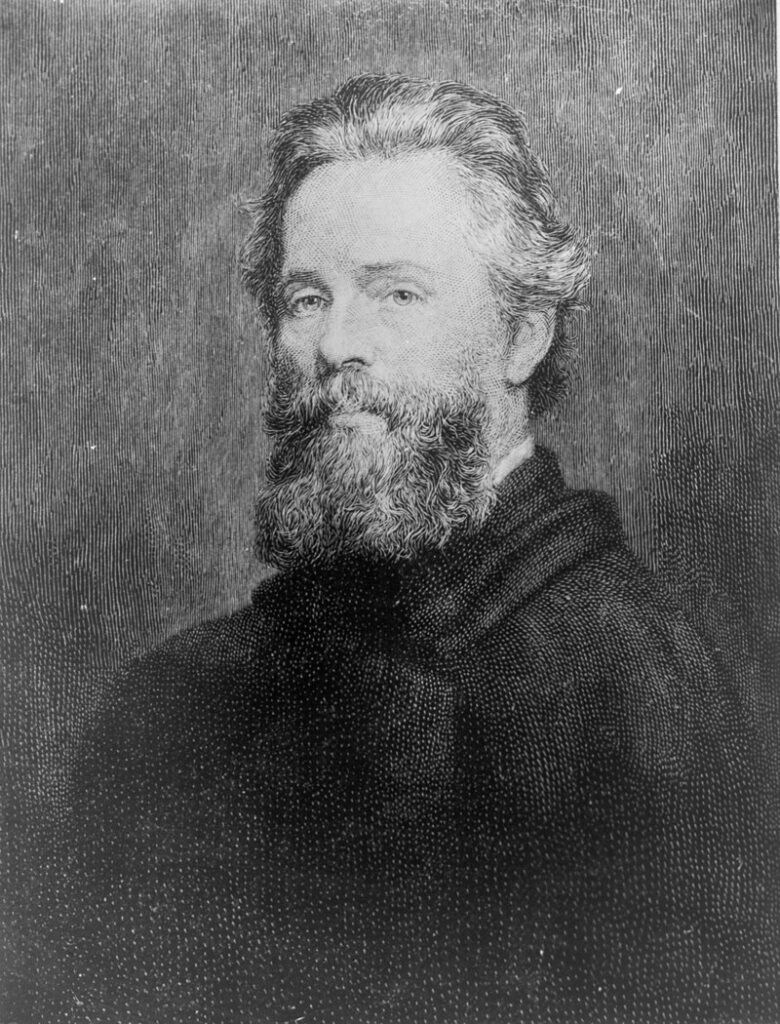

FROM WIKIPEDIA COMMONS
Moby-Dick; or, The Whale is an 1851 novel by American writer Herman Melville. The book is the sailor Ishmael‘s narrative of the obsessive quest of Ahab, captain of the whaling ship Pequod, for revenge on Moby Dick, the giant white sperm whale that on the ship’s previous voyage bit off Ahab’s leg at the knee. A contribution to the literature of the American Renaissance, Moby-Dick was published to mixed reviews, was a commercial failure, and was out of print at the time of the author’s death in 1891. Its reputation as a “Great American Novel” was established only in the 20th century, after the centennial of its author’s birth. William Faulkner said he wished he had written the book himself, and D. H. Lawrence called it “one of the strangest and most wonderful books in the world” and “the greatest book of the sea ever written”. Its opening sentence, “Call me Ishmael”, is among world literature’s most famous.
Melville began writing Moby-Dick in February 1850, and finished 18 months later, a year longer than he had anticipated. Melville drew on his experience as a common sailor from 1841 to 1844, including several years on whalers, and on wide reading in whaling literature. The white whale is modeled on the notoriously hard-to-catch albino whale Mocha Dick, and the book’s ending is based on the sinking of the whaleship Essex in 1820. His literary influences include Shakespeare and the Bible. The detailed and realistic descriptions of whale hunting and of extracting whale oil, as well as life aboard ship among a culturally diverse crew, are mixed with exploration of class and social status, good and evil, and the existence of God. In addition to narrative prose, Melville uses styles and literary devices ranging from songs, poetry, and catalogs to Shakespearean stage directions, soliloquies, and asides. In August 1850, with the manuscript perhaps half finished, he met Nathaniel Hawthorne and was deeply moved by his Mosses from an Old Manse, which he compared to Shakespeare in its cosmic ambitions. This encounter may have inspired him to revise and expand Moby-Dick, which is dedicated to Hawthorne, “in token of my admiration for his genius”.
The book was first published (in three volumes) as The Whale in London in October 1851, and under its definitive title in a single-volume edition in New York in November. The London publisher, Richard Bentley, censored or changed sensitive passages; Melville made revisions as well, including a last-minute change to the title for the New York edition. The whale, however, appears in the text of both editions as “Moby Dick”, without the hyphen. Reviewers in Britain were largely favorable, though some objected that the tale seemed to be told by a narrator who perished with the ship, as the British edition lacked the Epilogue recounting Ishmael’s survival. American reviewers were more hostile.
TODAY’S ALMANAC
1600s
1730s
1760s
1840s
1850s
1860s
1880s
- BORN 1885: SONIA DELAUNAY (ARTIST)
- 1889: JOURNALIST NELLIE BLY LEFT N.Y.C. FOR TOUR AROUND THE WORLD IN 72 DAYS
1890s
1900s
1910s
- 1910: EUGENE ELY PILOTED THE FIRST AIRPLANE TAKE-OFF FROM A SHIP
- DIED 1915: BOOKER T. WASHINGTON (EDUCATOR & ACTIVIST)
- BORN 1916: SHERWOOD SCHWARTZ (WRITER & PRODUCER)
- BORN 1919: VERONICA LAKE (ACTRESS)
1920s
1930s
1950s
1960s
- BORN 1966: CURT SCHILLING (BASEBALL PLAYER)
- 1968: YALE UNIVERSITY ANNOUNCES THAT IT WILL BEGIN ADMITTING WOMEN AS UNDERGRADUATE STUDENTS IN 1969
- 1969: APOLLO 12 SPACECRAFT SUCCESSFULLY LAUNCHED FROM CAPE KENNEDY
1970s
- BORN 1972: JOSH DUHAMEL (ACTOR)
- 1973: PRINCESS ANNE MARRIED CAPTAIN MARK PHILLIPS AT WESTMINSTER ABBEY
- BORN 1974: CHIP GAINES (HOME IMPROVEMENT EXPERT)
1980s
- 1981: SECOND SUCCESSFUL LANDING OF SPACE SHUTTLE COLUMBIA
- 1982: JEAN DRAPEAU BECAME MAYOR OF MONTREAL FOR 8TH TIME
- 1989: FIRST CABOOSELESS CANADIAN PACIFIC TRAIN LEFT WINNIPEG, MANITOBA, BOUND FOR THUNDER BAY, ONTARIO
2000s
COURTESY www.almanac.com

Very nice article and right to the point. I don’t know if this is truly the best place to ask but do you guys have any thoughts on where to get some professional writers? Thanks in advance 🙂